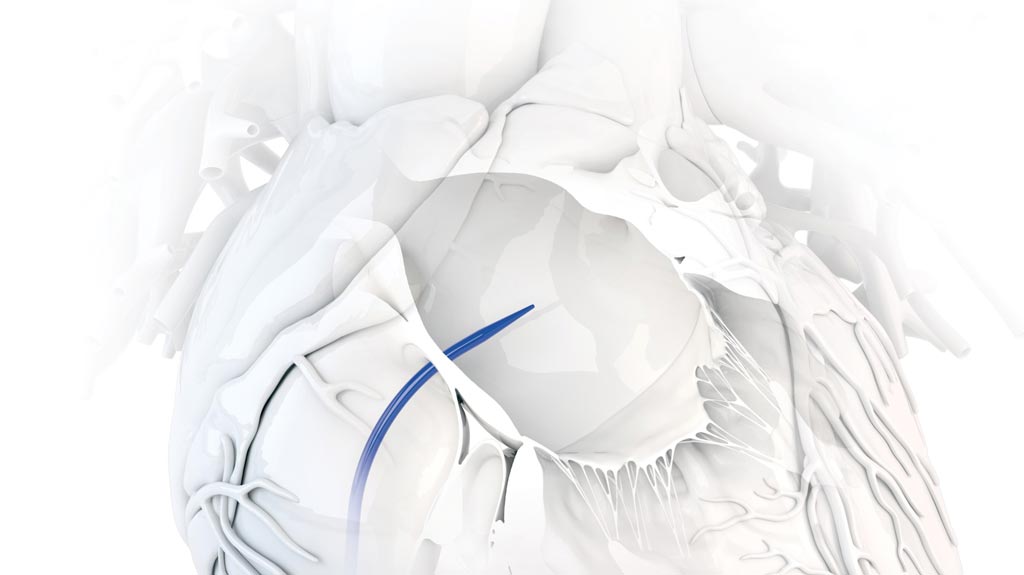Transseptal Access Dilator Facilitates LAA Closure
|
By HospiMedica International staff writers Posted on 16 May 2019 |

Image: The ExpanSure Transseptal Dilation System (Photo courtesy of Baylis Medical).
A new dilation system with a larger diameter optimizes left-heart procedures that require a large sheath to cross the heart's septum from the right atrium.
The Baylis Medical (Montreal, Canada) ExpanSure Transseptal Dilation System combines a sheath and dilator into a single braided composite tool, eliminating the traditional dilator-sheath transition that demands the use of added force to achieve crossing and allowing larger dilations, when compared to the standard fixed curve sheath. The system is intended for procedures such as left-atrial appendage (LAA) closure and balloon ablation for atrial fibrillation (AF). Features include a 12.5 Fr outer diameter, which pre-dilates the transseptal puncture, and a 0.035" inner diameter that allows physicians to engage their preferred wire without having to exchange for a compatible dilator.
“Crossing a 14 F sheath across the septum is often challenging, and, in certain cases, additional devices are needed to facilitate left-atrial access. Research has shown that introducing additional dilation devices may result in adverse events to the patient,” said Oussama Wazni, MD, section head of electrophysiology at the Cleveland Clinic (CC; OH, USA), who performed the first ExpanSure clinical case in the US. “Clinical evidence has shown that the dilator-sheath transition found in typically-used devices can cause septal tissue to get caught, resulting in difficulty crossing the septum.”
“Baylis is proud to offer a device uniquely designed to optimize transseptal access, allowing the physician's primary focus to remain on delivering the necessary therapy to the patient,” said Robert Harrison, director of research and development in cardiology at Baylis Medical. “We are delighted to have partnered with Dr. Wazni and the Cleveland Clinic for this successful first clinical use.”
Access to the left side of the heart is required for various therapies, including pulmonary vein isolation (PVI), mitral valve repair, and LAA closure. These procedures are typically performed through an atrial septal puncture. Once access to the left atrium is achieved, the role of a transseptal sheath and dilator set differs depending on the therapy being performed. Although the use of the sheath may vary, the ability to precisely control the distal end of the sheath during the atrial septal puncture is a common requirement.
Related Links:
Baylis Medical
Cleveland Clinic
The Baylis Medical (Montreal, Canada) ExpanSure Transseptal Dilation System combines a sheath and dilator into a single braided composite tool, eliminating the traditional dilator-sheath transition that demands the use of added force to achieve crossing and allowing larger dilations, when compared to the standard fixed curve sheath. The system is intended for procedures such as left-atrial appendage (LAA) closure and balloon ablation for atrial fibrillation (AF). Features include a 12.5 Fr outer diameter, which pre-dilates the transseptal puncture, and a 0.035" inner diameter that allows physicians to engage their preferred wire without having to exchange for a compatible dilator.
“Crossing a 14 F sheath across the septum is often challenging, and, in certain cases, additional devices are needed to facilitate left-atrial access. Research has shown that introducing additional dilation devices may result in adverse events to the patient,” said Oussama Wazni, MD, section head of electrophysiology at the Cleveland Clinic (CC; OH, USA), who performed the first ExpanSure clinical case in the US. “Clinical evidence has shown that the dilator-sheath transition found in typically-used devices can cause septal tissue to get caught, resulting in difficulty crossing the septum.”
“Baylis is proud to offer a device uniquely designed to optimize transseptal access, allowing the physician's primary focus to remain on delivering the necessary therapy to the patient,” said Robert Harrison, director of research and development in cardiology at Baylis Medical. “We are delighted to have partnered with Dr. Wazni and the Cleveland Clinic for this successful first clinical use.”
Access to the left side of the heart is required for various therapies, including pulmonary vein isolation (PVI), mitral valve repair, and LAA closure. These procedures are typically performed through an atrial septal puncture. Once access to the left atrium is achieved, the role of a transseptal sheath and dilator set differs depending on the therapy being performed. Although the use of the sheath may vary, the ability to precisely control the distal end of the sheath during the atrial septal puncture is a common requirement.
Related Links:
Baylis Medical
Cleveland Clinic
Latest Surgical Techniques News
- Minimally Invasive Endoscopic Surgery Improves Severe Stroke Outcomes
- Novel Glue Prevents Complications After Breast Cancer Surgery
- Breakthrough Brain Implant Enables Safer and More Precise Drug Delivery
- Bioadhesive Sponge Stops Uncontrolled Internal Bleeding During Surgery
- Revolutionary Nano Bone Material to Accelerate Surgery and Healing
- Superior Orthopedic Implants Combat Infections and Quicken Healing After Surgery
- Laser-Based Technique Eliminates Pancreatic Tumors While Protecting Healthy Tissue
- Surgical Treatment of Severe Carotid Artery Stenosis Benefits Blood-Brain Barrier
- Revolutionary Reusable Duodenoscope Introduces 68-Minute Sterilization
- World's First Transcatheter Smart Implant Monitors and Treats Congestion in Heart Failure
- Hybrid Endoscope Marks Breakthrough in Surgical Visualization
- Robot-Assisted Bronchoscope Diagnoses Tiniest and Hardest to Reach Lung Tumors
- Diamond-Titanium Device Paves Way for Smart Implants that Warn of Disease Progression
- 3D Printable Bio-Active Glass Could Serve as Bone Replacement Material
- Spider-Inspired Magnetic Soft Robots to Perform Minimally Invasive GI Tract Procedures
- Micro Imaging Device Paired with Endoscope Spots Cancers at Earlier Stage
Channels
Critical Care
view channel
Light-Based Technology to Measure Brain Blood Flow Could Diagnose Stroke and TBI
Monitoring blood flow in the brain is crucial for diagnosing and treating neurological conditions such as stroke, traumatic brain injury (TBI), and vascular dementia. However, current imaging methods like... Read more
AI Heart Attack Risk Assessment Tool Outperforms Existing Methods
For decades, doctors have relied on standardized scoring systems to assess patients with the most common type of heart attack—non-ST-elevation acute coronary syndrome (NSTE-ACS). The GRACE score, used... Read morePatient Care
view channel
Revolutionary Automatic IV-Line Flushing Device to Enhance Infusion Care
More than 80% of in-hospital patients receive intravenous (IV) therapy. Every dose of IV medicine delivered in a small volume (<250 mL) infusion bag should be followed by subsequent flushing to ensure... Read more
VR Training Tool Combats Contamination of Portable Medical Equipment
Healthcare-associated infections (HAIs) impact one in every 31 patients, cause nearly 100,000 deaths each year, and cost USD 28.4 billion in direct medical expenses. Notably, up to 75% of these infections... Read more
Portable Biosensor Platform to Reduce Hospital-Acquired Infections
Approximately 4 million patients in the European Union acquire healthcare-associated infections (HAIs) or nosocomial infections each year, with around 37,000 deaths directly resulting from these infections,... Read moreFirst-Of-Its-Kind Portable Germicidal Light Technology Disinfects High-Touch Clinical Surfaces in Seconds
Reducing healthcare-acquired infections (HAIs) remains a pressing issue within global healthcare systems. In the United States alone, 1.7 million patients contract HAIs annually, leading to approximately... Read moreHealth IT
view channel
Printable Molecule-Selective Nanoparticles Enable Mass Production of Wearable Biosensors
The future of medicine is likely to focus on the personalization of healthcare—understanding exactly what an individual requires and delivering the appropriate combination of nutrients, metabolites, and... Read moreBusiness
view channel
Philips and Masimo Partner to Advance Patient Monitoring Measurement Technologies
Royal Philips (Amsterdam, Netherlands) and Masimo (Irvine, California, USA) have renewed their multi-year strategic collaboration, combining Philips’ expertise in patient monitoring with Masimo’s noninvasive... Read more
B. Braun Acquires Digital Microsurgery Company True Digital Surgery
The high-end microsurgery market in neurosurgery, spine, and ENT is undergoing a significant transformation. Traditional analog microscopes are giving way to digital exoscopes, which provide improved visualization,... Read more
CMEF 2025 to Promote Holistic and High-Quality Development of Medical and Health Industry
The 92nd China International Medical Equipment Fair (CMEF 2025) Autumn Exhibition is scheduled to be held from September 26 to 29 at the China Import and Export Fair Complex (Canton Fair Complex) in Guangzhou.... Read more














